Disassembly Procedure
Tools Required
- Remove the starter motor from the vehicle. Refer to
Starter Motor Replacement
.
- Refer to
Starting System Description
.
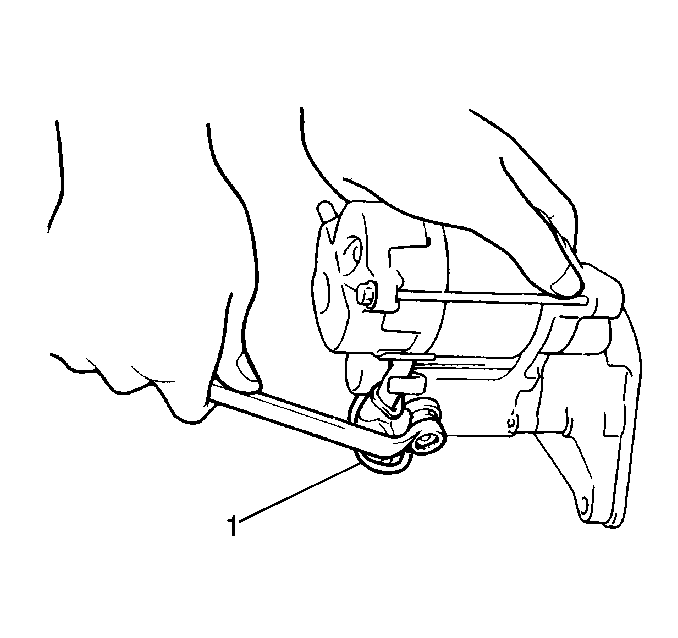
- Remove the nut and the
solenoid wire (1) from the solenoid assembly.
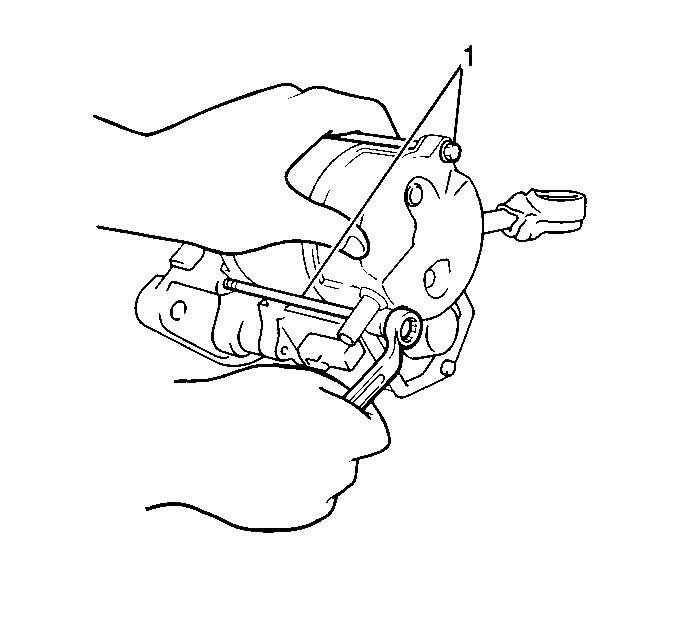
- Remove the two through
bolts (1) and separate the field frame (with armature) from the solenoid
assembly.
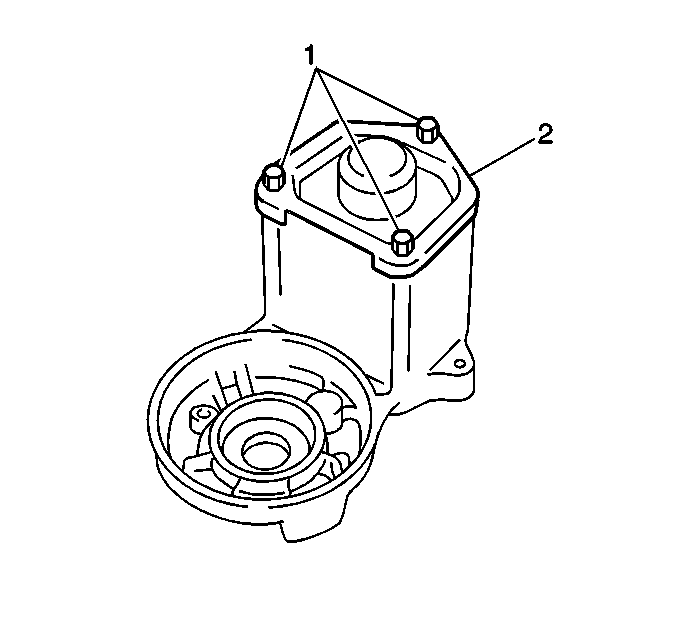
- Remove the three bolts (1)
and the solenoid end cover (2).
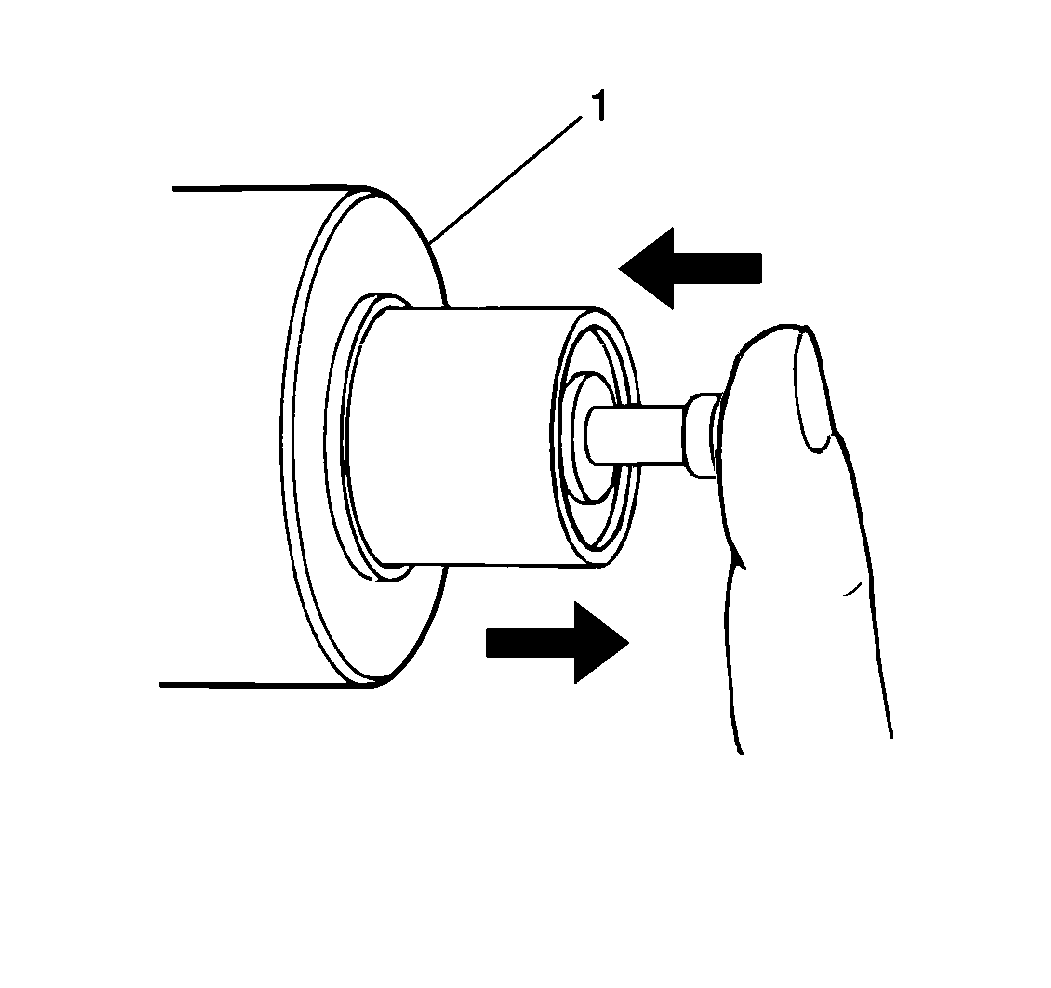
- Inspect the starter solenoid
plunger by pressing the plunger in and releasing the plunger. If the plunger
does not return to its original position quickly, replace the starter
solenoid.
- Remove the solenoid plunger.
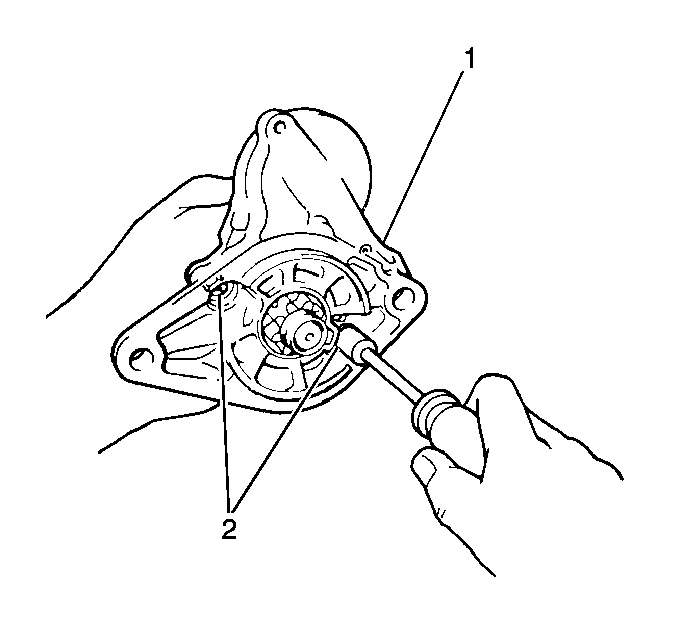
- Remove the two bolts (2)
and separate the drive housing (1) from the solenoid assembly.
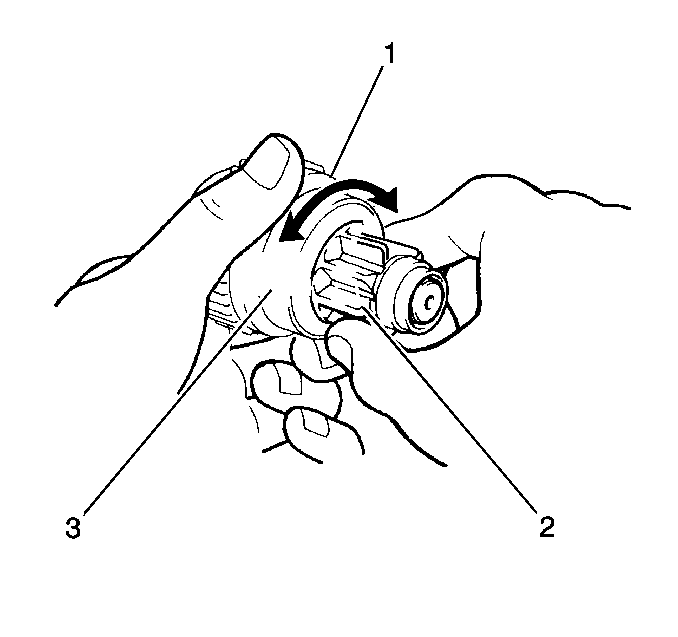
- Inspect the overrunning
clutch (1) for wear, damage and other abnormal conditions.
Verify that the following conditions exist:
| • | The clutch locks when it is turned in the drive direction. |
| • | The clutch rotates smoothly in the reverse direction. |
| • | Replace the clutch assembly as necessary. |
- Inspect the overrunning clutch spline teeth (2) for wear
and damage. Replace the clutch assembly as necessary.
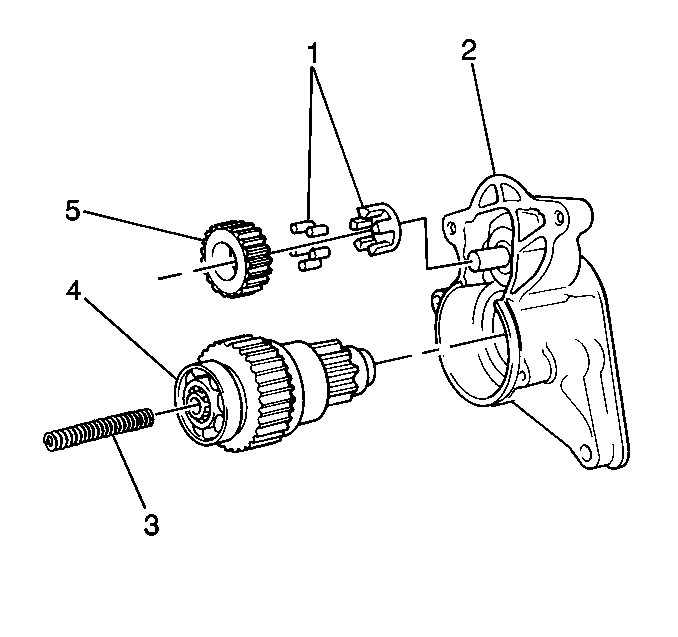
- Remove the idler gear (5)
from the drive housing.
- Carefully remove the idler gear roller bearing (1) from
the drive housing. The needle bearings may fall out during disassembly.
- Remove the return spring (3) from the drive housing.
- Remove the clutch and drive assembly (4) from the drive
housing by gently tapping on the pinion end with a rawhide mallet.
- Inspect the drive housing assembly components for wear, damage
or other abnormalities.
- Replace the components as necessary.
- Inspect the clutch and drive assembly bearings for wear, damage
and smooth operation.
- Replace the bearings as necessary.
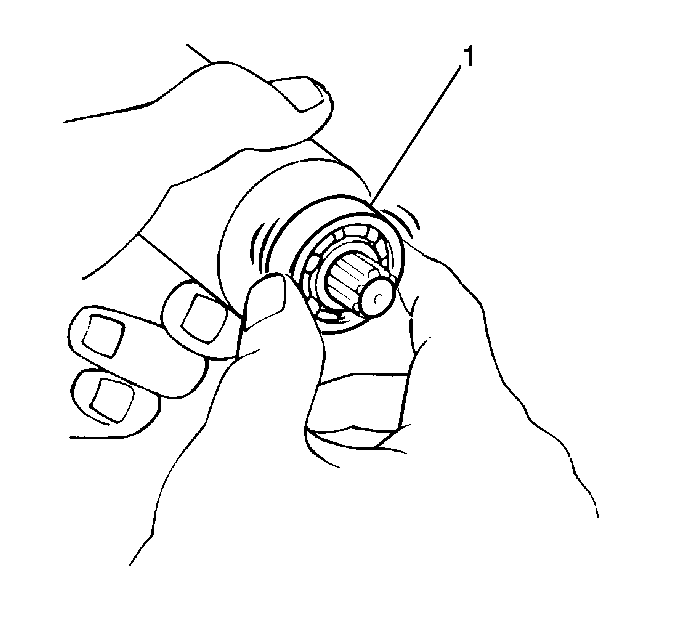
- Inspect the armature
bearings (1) for smooth operation, wear and damage.
- Replace the bearings as necessary.
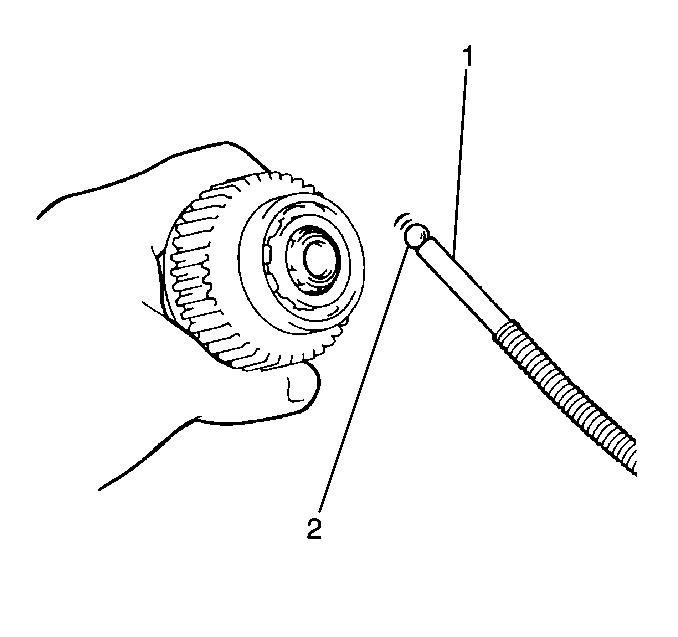
- Remove the steel ball (2)
from the clutch and drive assembly.
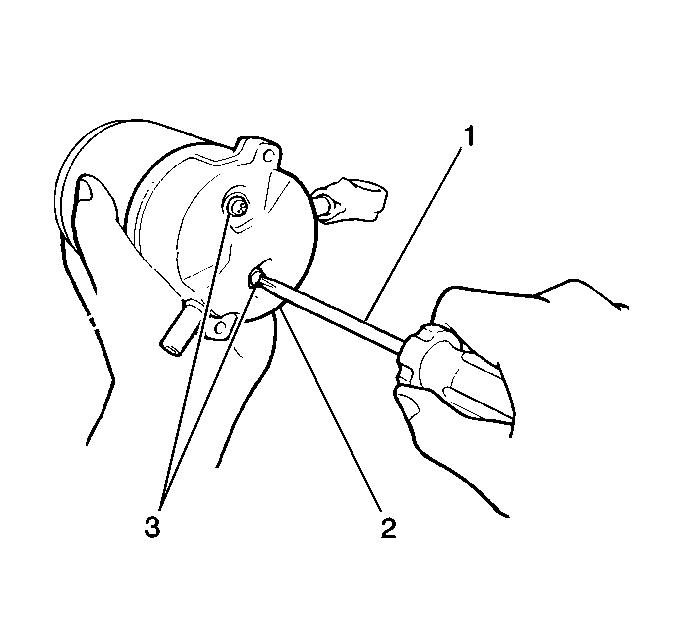
- Remove the following components
from the field frame:
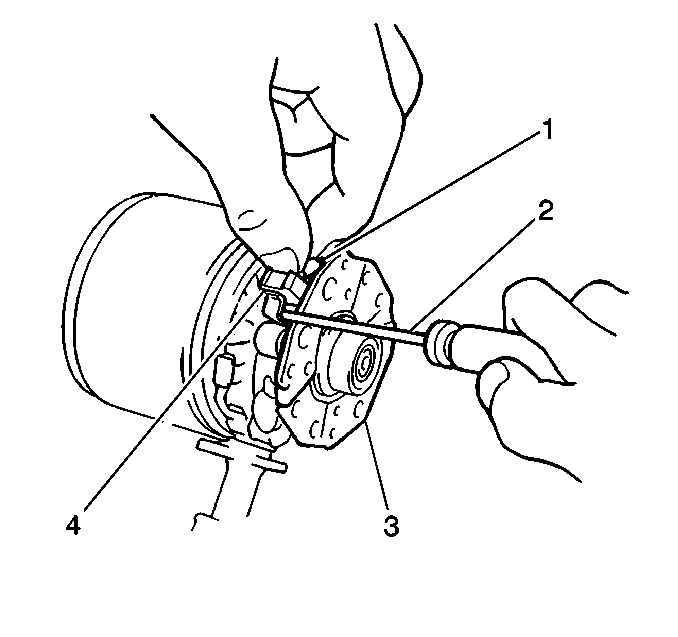
- Remove the brushes.
- Hold the spring back with a small screwdriver (2) and remove
the brush (4) from the brush holder.
- Disconnect the four brushes.
- Remove the brush holder.
- Remove the armature from the field frame.
- Inspect the brush springs for corrosion and damage. Replace the
components as necessary.
- Inspect the brush holder and the insulation on the positive plates
for wear and damage. Replace the components as necessary.
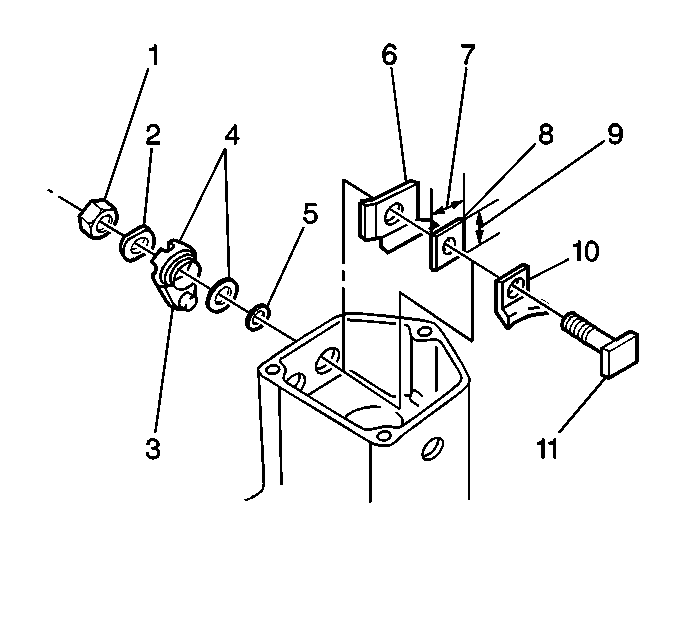
- Remove the following from
terminal 30 of the solenoid assembly:
| 30.2. | The wave washer (2) |
| 30.3. | The outside insulator (4) |
| 30.6. | The contact plate (10) |
| 30.7. | The inside insulator (8) |
| 30.8. | The insulation paper (6) |
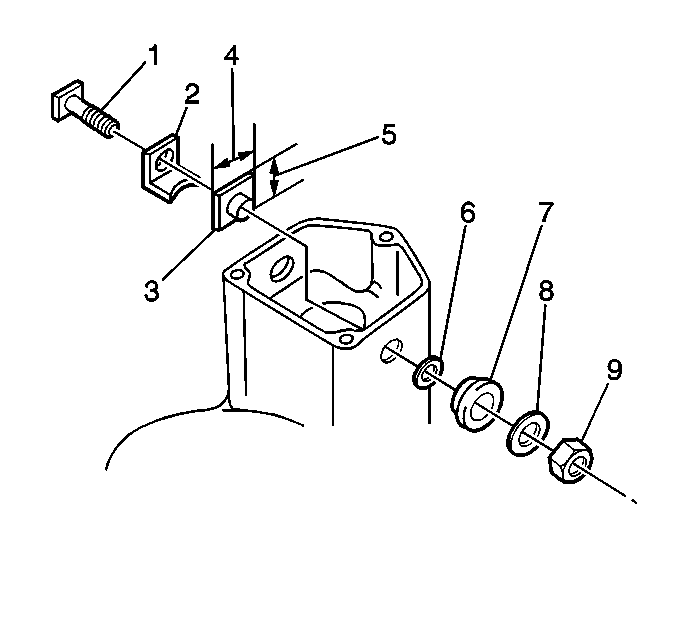
- Remove the following from
terminal C of the solenoid assembly:
| 31.2. | The wave washer (8) |
| 31.3. | The outside insulator (7) |
| 31.6. | The contact plate (2) |
| 31.7. | The inside insulator (3) |
Inspection and Measuring Procedure
Notice: Do not use grease dissolving solvents for cleaning the overrunning clutch
or armature. Solvents dissolve the grease packed in the clutch and damage
the armature and the field coil insulation.
- Clean all of the starter motor parts.
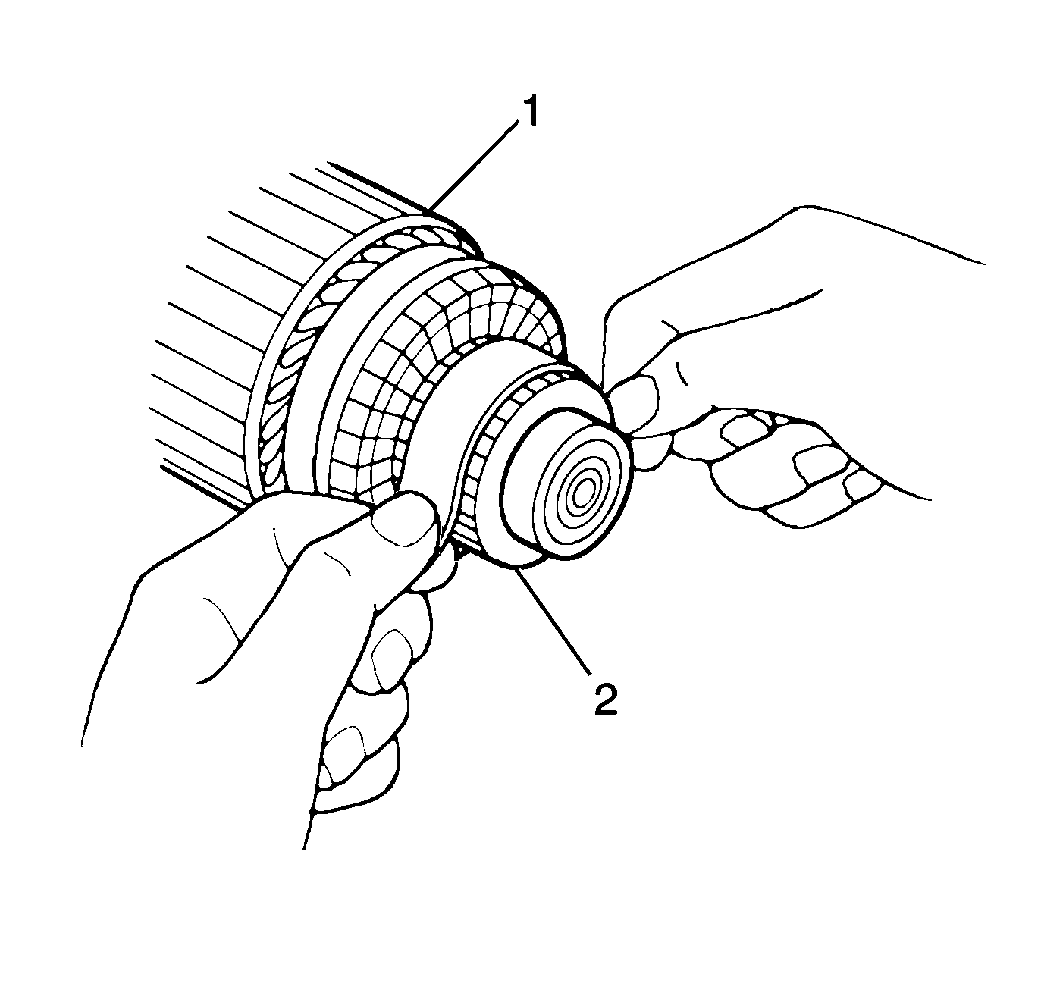
- Remove dirt and burn marks
from the commutator end (2) of the armature (1). Sand the marks
using a #300 or #400 grit sandpaper. Wipe the parts using a clean
shop cloth.
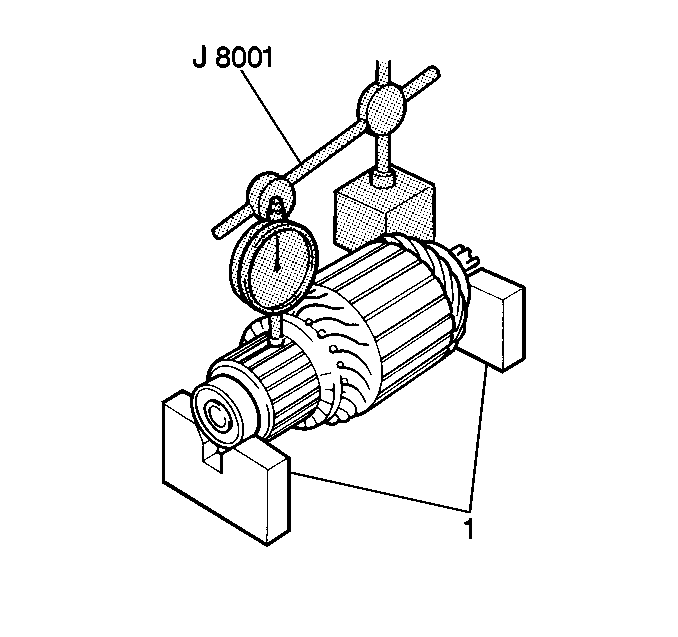
- Place the armature onto
a pair of V-blocks (1).
- Measure the commutator runout using the J 8001
with the J 26900-13
. Replace the armature if the runout exceeds the standard.
Standard Commutator Runout
0.05 mm (0.002 in)
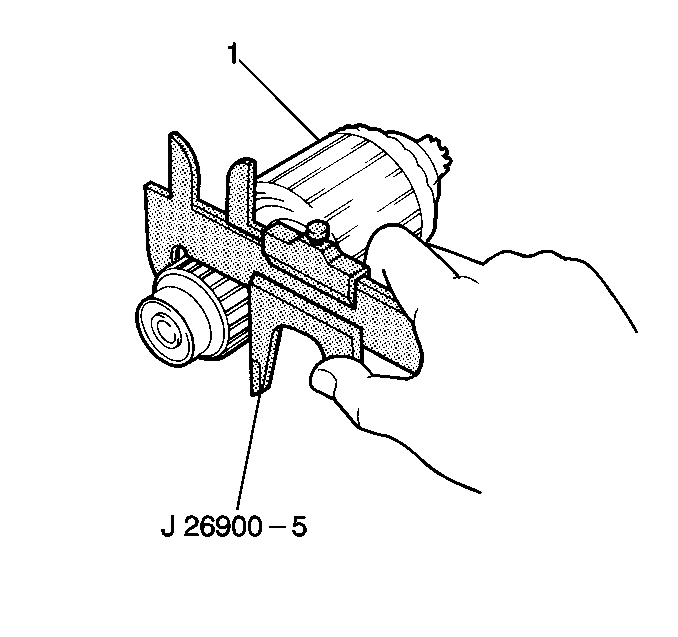
- Measure the commutator
wear using the J 26900-5
.
Replace the armature (1) if the diameter is less than the minimum.
Standard Commutator Diameter
30 mm (1.18 in)
Minimum Commutator Diameter
29 mm (1.14 in)
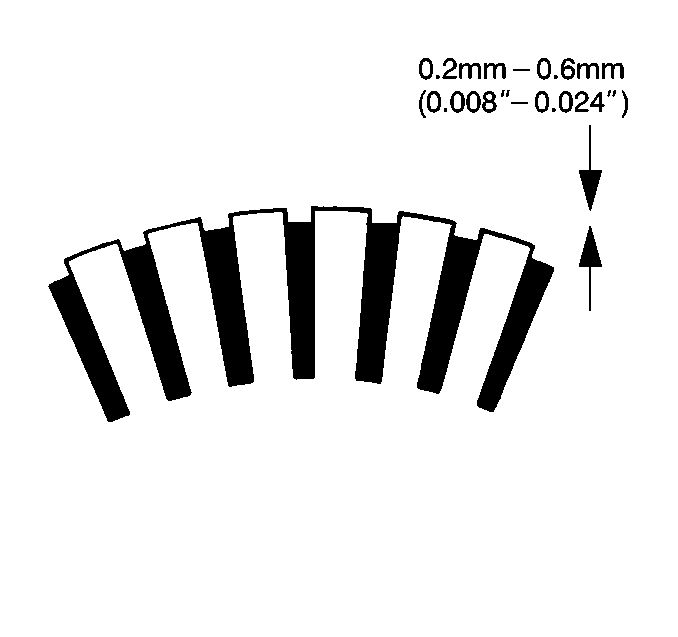
- Measure the commutator
insulation depth. Replace the armature if the insulation depth is less than
the minimum.
Standard Commutator Insulation Depth
0.6 mm (0.024 in)
Minimum Commutator Insulation Depth
0.2 mm (0.008 in)
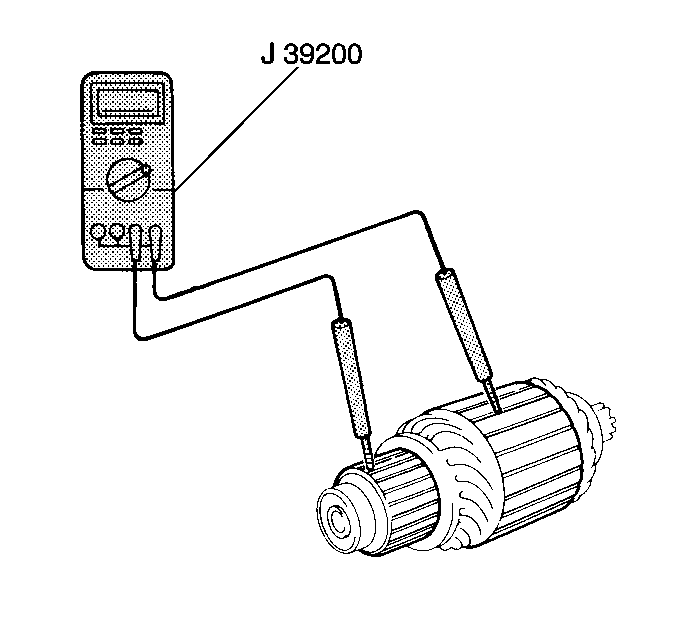
- Measure the resistance
between the armature core and the commutator using the J 39200
. If the resistance is 5.0 ohms
or less, the armature is grounded. Replace the armature.
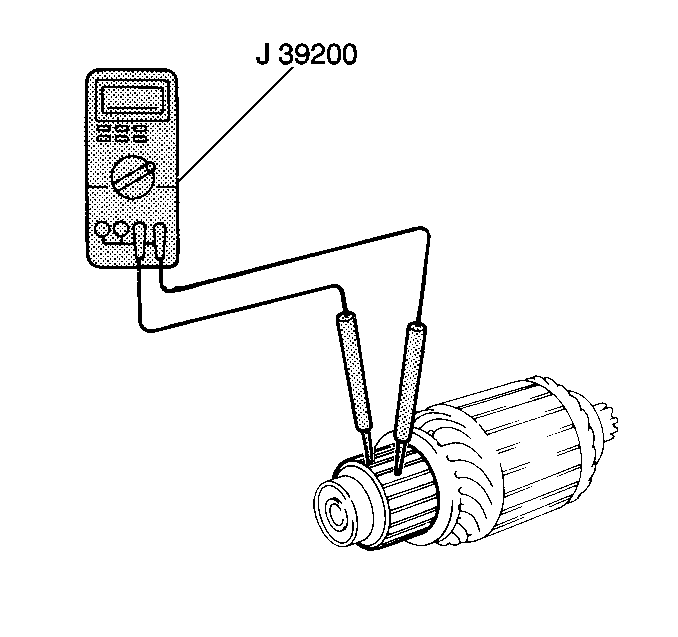
- Measure the resistance
between the commutator segments using the J 39200
. If the resistance is not 5.0 ohms or less
at any test point, there is an open circuit in the commutator.
Replace the armature.
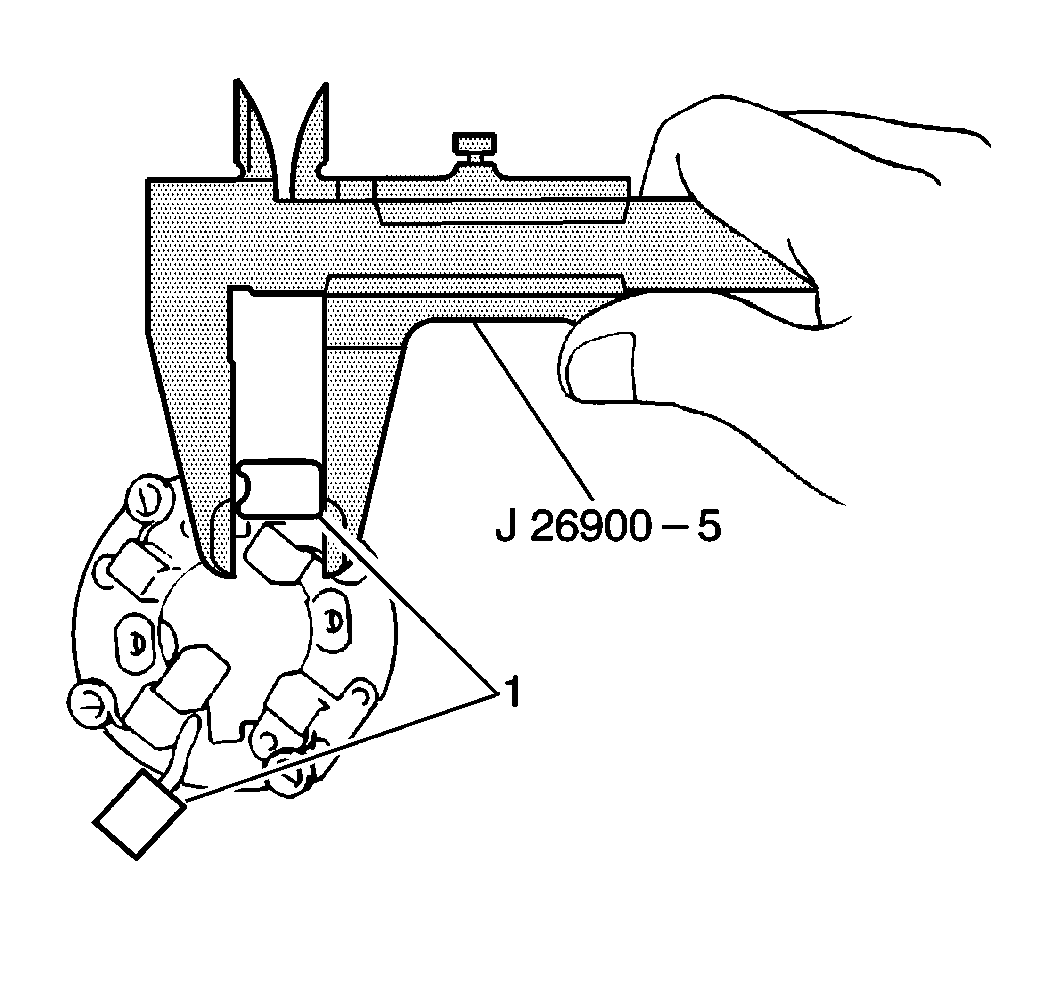
- Measure the positive brush (1)
length using the J 26900-5
.
If the brush length is less than the minimum, replace the brush holder.
Standard Brush Length
15.5 mm (0.610 in)
Minimum Brush Length
10.0 mm (0.394 in)
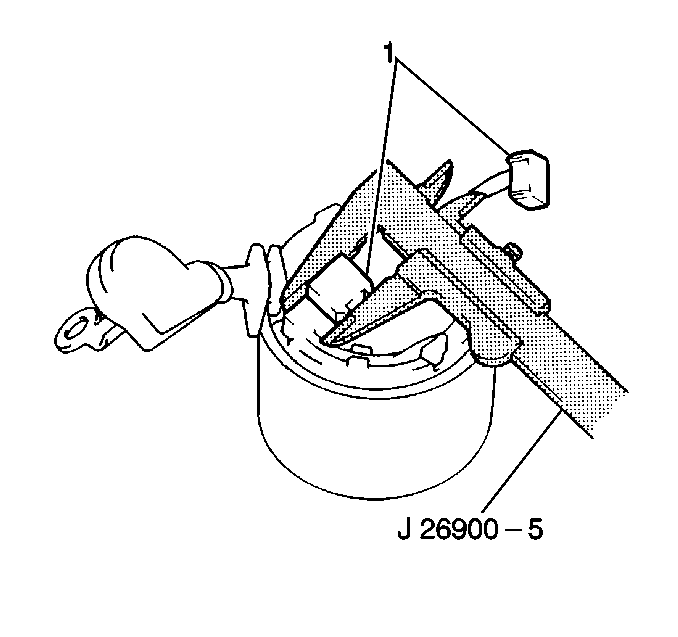
- Measure the negative brush (1)
length using the J 26900-5
.
If the brush length is less than the minimum, replace the field frame.
Standard Brush Length
15.5 mm (0.610 in)
Minimum Brush Length
10.0 mm (0.394 in)
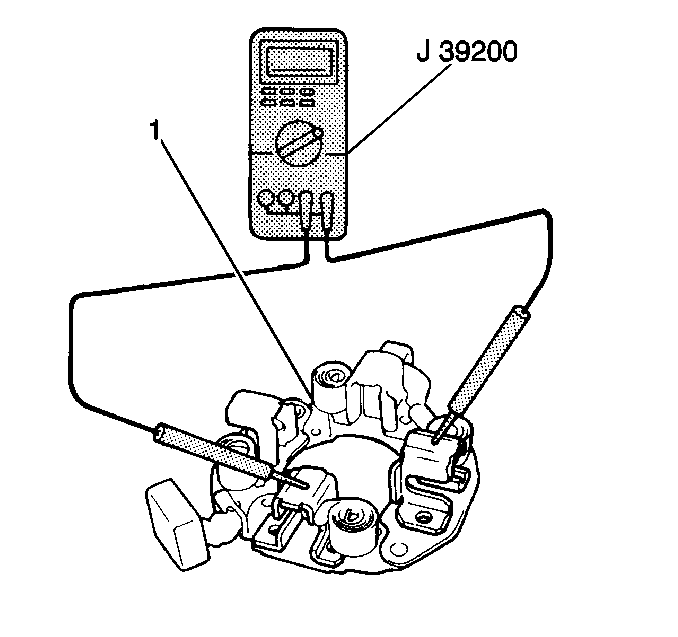
- Measure the resistance
between the positive brush holder and the negative brush holder using the J 39200
. If the resistance is
5.0 ohms or less, the brush holder is grounded. Replace the
brush holder (1).
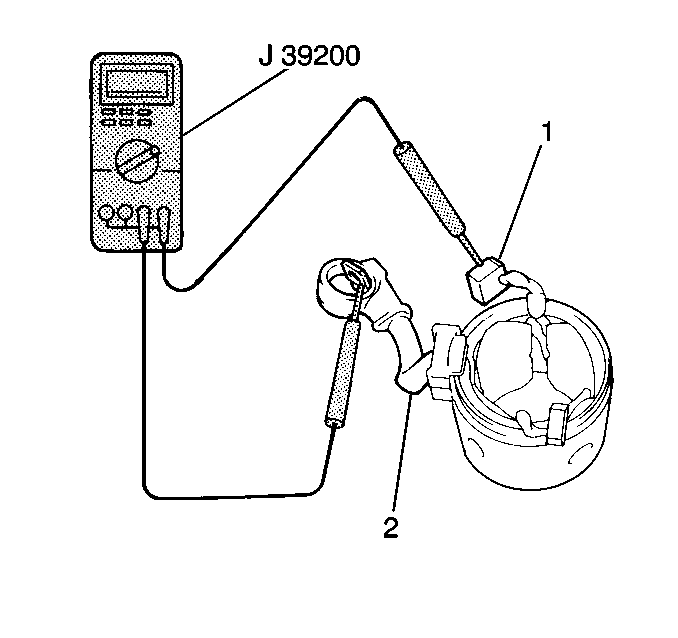
- Measure the resistance
between the lead wire (2) and the field coil brush lead (1)
using the J 39200
. If the
resistance is greater than 5.0 ohms replace the field frame.
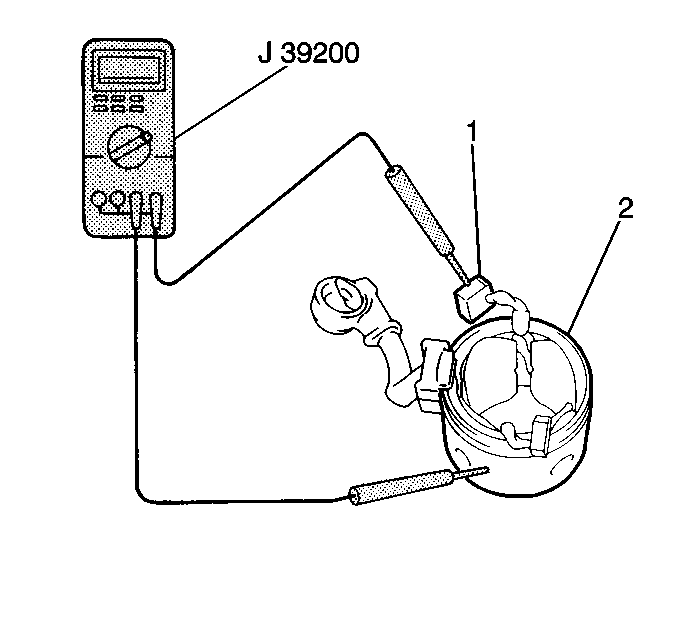
- Measure the resistance
between the field coil brush lead (1) and the field frame (2)
using the J 39200
. If the
resistance is less than 5.0 ohms replace the field frame.
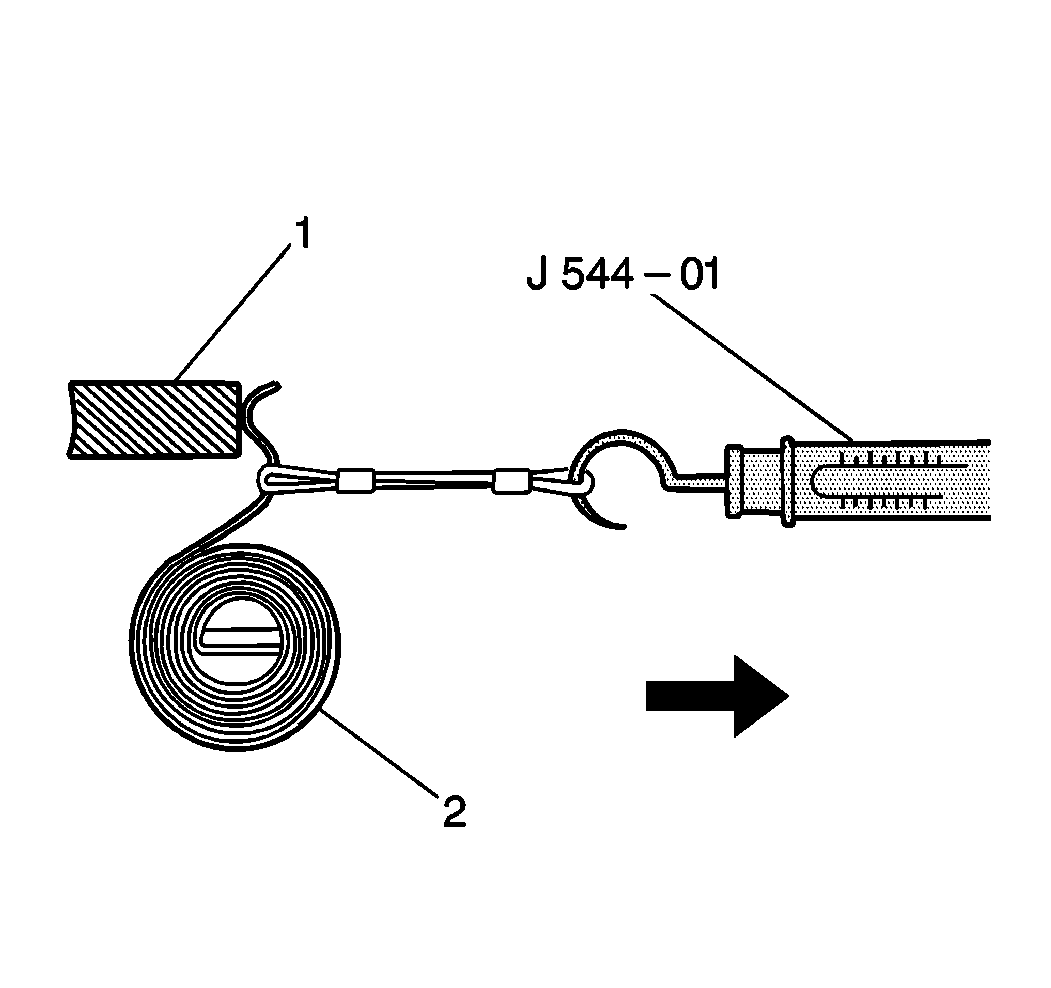
- Measure the brush spring (2)
tension using the J 544-01
.
Take the reading as soon as the brush spring separates from the brush. If
the tension is less than the minimum, replace the brush spring.
Standard Brush Spring Tension
1.8-2.4 kg (4.0-5.3 lb)
Minimum Brush Spring Tension
1.2 kg (2.6 lb)
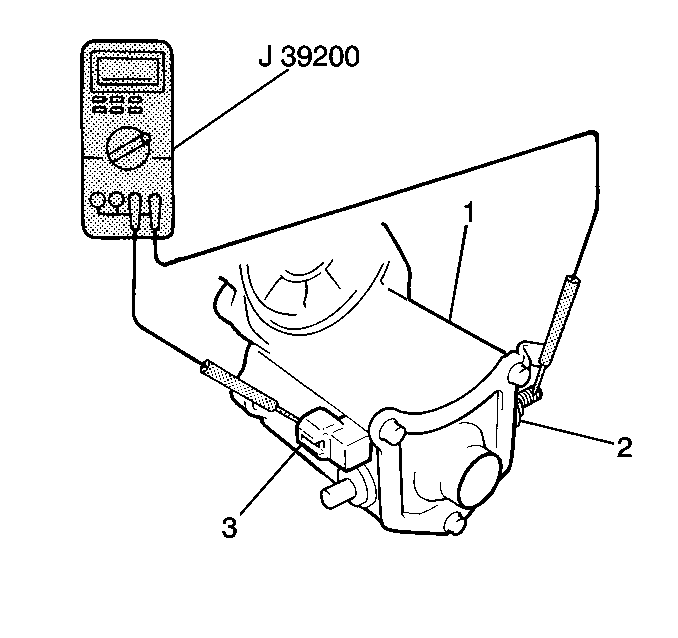
- Measure the starter solenoid
pull in coil resistance between terminals 50 (3) and C (2)
using the J 39200
. If the
resistance is not 5 ohms or less, the pull-in coil is open.
Replace the starter solenoid.
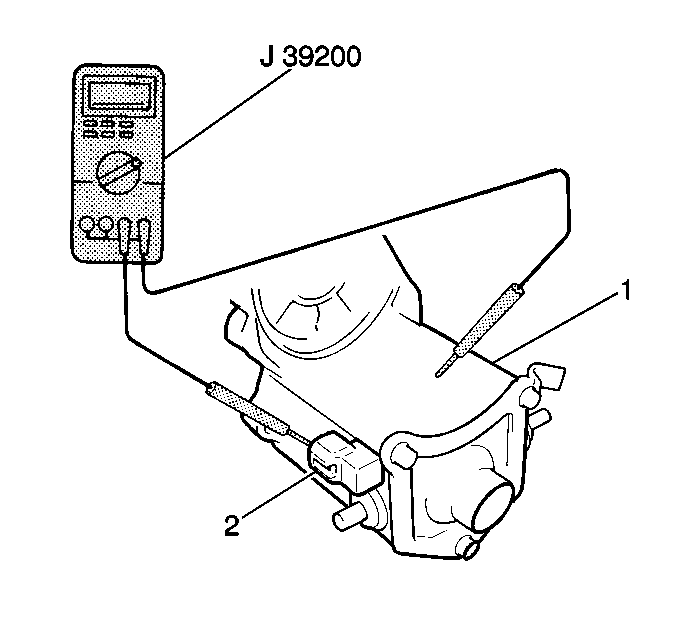
- Measure the starter solenoid
hold-in coil resistance between terminal 50 (2) and the solenoid
case using the J 39200
.
If the resistance is not 5.0 ohms or less, the hold-in
coil is open. Replace the starter solenoid.
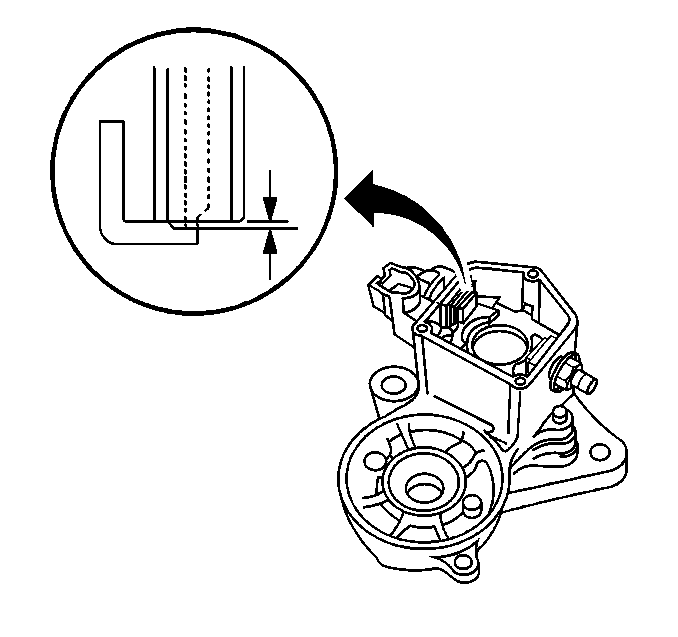
- Measure the contact plate
wear using the J 26900-5
.
If the depth of wear is greater than 0.9 mm (0.035 in) replace
the contact plate.
Assembly Procedure

- Install the following
to terminal 30:
| 1.1. | The insulation paper (6) |
| 1.2. | The inside insulator (8); long side (7), short side (9) |
| 1.3. | The contact plate (10) |
| 1.4. | The terminal bolt (11) |
| 1.6. | The packing and outside insulator (4) |
- Do not tighten the nut (1) at this time.

- Install the following
to terminal C:
| 3.1. | The inside insulator (3); long side (4), short side (5) |
| 3.2. | The contact plate (2) |
| 3.3. | The terminal bolt (1) |
| 3.5. | The outside insulator (7) |
| 3.7. | The terminal nut (9) |
- Do not tighten the nut (9) at this time.
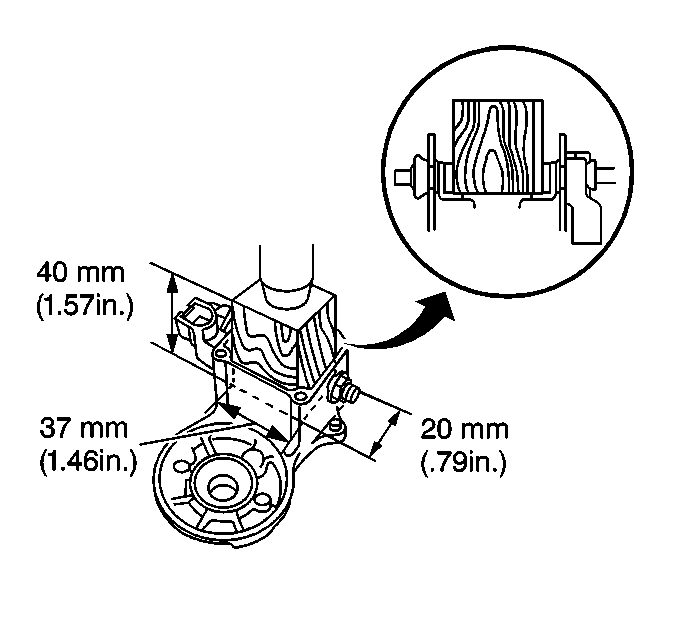
Important: If the contact plate is not pressed down evenly, the contact plate may
tilt due to the tightening of the nut. If the nut is over tightened, it may
cause cracks on the inside of the insulator.
Notice: Use the correct fastener in the correct location. Replacement fasteners
must be the correct part number for that application. Fasteners requiring
replacement or fasteners requiring the use of thread locking compound or sealant
are identified in the service procedure. Do not use paints, lubricants, or
corrosion inhibitors on fasteners or fastener joint surfaces unless specified.
These coatings affect fastener torque and joint clamping force and may damage
the fastener. Use the correct tightening sequence and specifications when
installing fasteners in order to avoid damage to parts and systems.
- Place a wooden block
on the contact plates and press it down with a hand press. Use only enough
force to hold the contact plates firmly seated in the solenoid assembly.
Tighten the nuts.
Dimensions of the wooden block are 20x37x40 mm (0.79x1.46x1.57 in).
Tighten
Tighten the nuts to 17 N·m (12 lb ft).
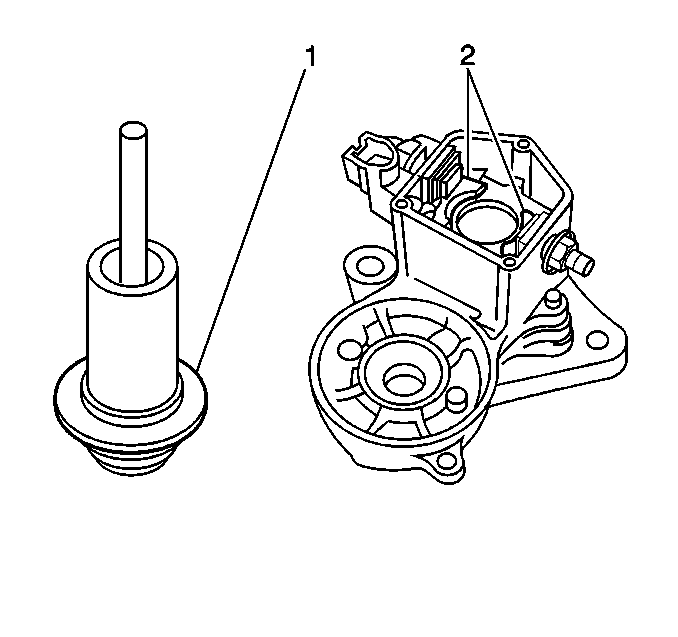
- Clean the contact surfaces
of the contact plates (2) and the plunger (1) with a clean dry
cloth.
- Install the solenoid plunger.
- Install the solenoid end cover.
Tighten
Tighten the nuts to 2.5 N·m (23 lb in).
- Apply a light coating of Lubriplate lubricant GM P/N 1050109,
or an equivalent, to the following locations:
| • | The front armature bearing |
| • | The rear armature bearing |
| • | The idler gear roller bearing |

- Install the armature into
the field frame.
- Install the brush holder.
- Connect the four brushes.
- Hold the spring back with a small screwdriver (2) and install
the brush (4) into the brush holder.

- Install the end cover (2)
to the field frame.
| • | Install the two screws (3) |
Tighten
Tighten the screws to 1.5 N·m (13 lb in).

- Install the steel ball (2)
to the clutch and drive assembly.

- Install the following
to the drive housing:
| • | The idler gear roller bearing (1) |
| • | The clutch and drive assembly (4) |

- Install the drive housing (1)
to the solenoid assembly
Tighten
Tighten the two bolts to 6 N·m (52 lb in).

- Install the field frame
to the solenoid assembly using a new O-ring.
Tighten
Tighten the two through bolts (1) to 6 N·m (52 lb in).

- Install the solenoid lead
wire and nut (1) to the solenoid assembly.
Tighten
Tighten the nut (1) to 6 N·m (52 lb in).
- Install the starter motor to the vehicle. Refer to
Starter Motor Replacement
.







































